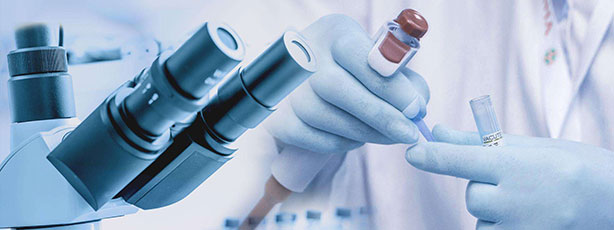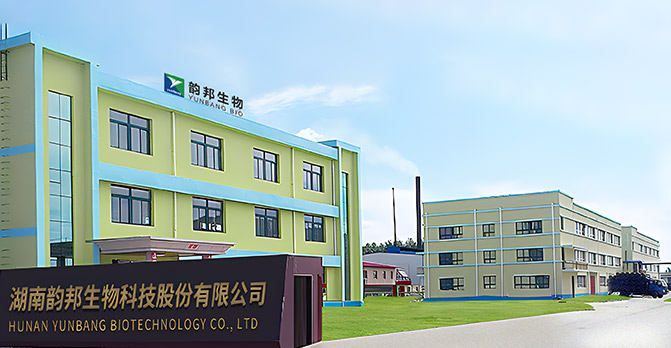 Biological buffers
Biological buffers

A biological buffer is a solution that maintains the pH of the solution relatively stable when small amounts of acid or base are added. Most cells can only operate in a very narrow pH range and require a buffering system to resist the pH changes that occur during metabolism.
 Hematology Stains
Hematology Stains

The current chromogenic substrates (new Trinder's reagents) are TOOS, TOPS, ADOS, ADPS, ALPS, DAOS, HDAOS, MADB, MAOS, TODB, etc.
 Zwitterionic Detergents
Zwitterionic Detergents

Bio Cleaner a kind of multiple spore mix biological preparation, which contains a new type of Ka bioflora, which has been proven to have excellent enzyme production performance and is widely used in organic waste treatment.
 Hyperpure Quaternary Ammonium Cation
Hyperpure Quaternary Ammonium Cation

Quaternary ammonium salts are generally less toxic and irritating than amines, which are widely present in living organisms and have extremely important physiological effects. Quaternary ammonium salts are chemically stable, non-flammable and non-explosive, and non-volatile.
Hunan Yunbang Biotech Inc. was established in 2008. Its predecessor originated from Beijing Yunbang Biosciences Co., Ltd. and moved to Changsha, Hunan in 2016. Is a professional engaged in research and development, production and sales in one of the of raw materials for IVD reagents, Biological buffers, Zwitterionic detergents,Pharmaceutical raw materials and Fine Chemicals.
The company is based in China and radiates to the world. It has been providing raw materials and customized synthesis services for many domestic and overseas biological enterprises.


Recently, the 8th Hunan Province Innovation and Entrepreneurship Competition with the theme of "Innovation and Entrepreneurship, Realizing Dreams of Hunan" held by the Science and Technology Department of Hunan Province kicked off. It has added a strong color to promoting the innovation and development of technology-based small, medium and micro enterprises A total of 19 companies from Huaihua participated in this competition, of which 6 companies in the growth group entered the ranks of the provincial excellence award. Hunan Yunbang Biopharmaceutical Co., Ltd., as a typical example of the outstanding enterprises, was recommended for selection. Huaihua Science and Technology Bureau attaches great importance to the selection of this innovation and entrepreneurship competition. Huaihua Science and Technology Bureau emphasizes that it will focus on creating a national innovative city, focus on promoting comprehensive innovation with scientific and technological innovation as the core, and speed up the construction of scientific and technological innovation system. The 14th Five-Year Plan has a good start and a good start, and contributes scientific and technological strength to vigorously implementing the strategy of "three highs and four new", striving to build "three cities and one district", and accelerating the process of modernization and new Huaihua. Hunan Yunbang, as the representative of its new power in ZTE, is bound to contribute to the vigorous development of Huaihua enterprises. Hunan Yunbang was established in 2014 and is located in Hongjiang Circulation High-tech Industrial Park, Huaihua City. It is a national high-tech enterprise integrating R&D, production, sales and service. It has an independent R&D test center and production base, and has passed the ISO9001:2015 quality system certification. It can provide users with high-quality and low-cost commissioned custom business and mass production services from gram to ton. The company has strong strength and has successively won the "National High-tech Enterprise", "Hunan Science and Technology Small and Medium-sized Enterprise", "Huaihua Engineering Technology Research Center", "Hunan Normal University Chemical Biology Functional Materials Industry-Academic Park Base", "Innovation and Entrepreneurship Competition Hunan Province Excellent Enterprise" " and a series of honorary titles. After years of hard work, the company has built a complete marketing system, and its products are exported to Southeast Asia, Europe and the United States and other countries and regions, and have been recognized and trusted by global customers. Hunan Yunbang also has its own independent reagent brand - "Huibai Reagent", with more than 10,000 kinds of reagent products. Huibai Reagent has established close cooperation with a number of scientific research institutions and colleges and universities, providing the most cost-effective biochemical reagents for the majority of R&D personnel.

Screening is the most important basic method in the development of modern small molecule drugs. To conduct screening, we must first discover the target of a drug that is indicative of a disease, such as receptors, enzymes, transporters or ion channels. , signal proteins, structural proteins, tubulin, actin, etc.; secondly, there must be a small molecule library (Library), which provides a sufficient number of molecules for screening, and finds one or more target compounds from the corresponding library that meet the requirements. (Hit), through layer-by-layer structure optimization, lead compounds (Lead) and candidate compounds (Candidate) are obtained, and their safety and effectiveness are fully verified through systematic clinical trials. With the rapid development of molecular biology and structural biology, small molecule drug discovery has entered the era of target-based drug design. Researchers can perform high-throughput screening based on a certain target to obtain the composite crystal structure of small molecules and target proteins, and rationally optimize them with the aid of computers, which makes the development of drugs clear and clear. However, High Throughput Screening (HTS), Virtual Screening (Virtual Screening), Structure-based Drug Design (SBDD) and Fragment-based Drug Discovery (FBDD) have gradually become small Common technologies for molecular drug discovery and development, these technologies have achieved great success and are still constantly enriched and developed. At the same time, there are many new technologies and methods in the field of small molecules, such as two protein degradation therapies, PROTAC and molecular glue. Among them, PROTAC technology is undoubtedly one of the most active small molecule research and development technologies. On July 20, 2021, a heavyweight Perspective: The PROTACtable genome was published in the journal Nature ReviewsDrug Discovery. It mainly explained proteolytic targeting chimeras (PROTACs), and proposed a system to evaluate the PROTACability of protein targets. (PROTACtability) method and 1,067 potential PROTAC targets. It is expected that by the end of 2021, at least 15 protein degradation therapies under investigation will enter the clinical trial stage, including at least 10 heterobifunctional protein degraders (PROTAC, BiDAC, etc.) and 5 molecular glue degraders. In addition, the application of new technologies such as DNA-encoded compound library (DEL) technology, gene encoding technology and AI technology will play an important role in the development of small molecule drugs, improving the efficiency, success rate and competitiveness of small molecule drug development. PROTAC (Proteolysis-Targeting Chimeras) is a drug development technology that utilizes the Ubiquitin-Proteasome System (UPS) to degrade target proteins. Raymond, Deshaies and others first proposed the concept of PROTAC in 2001, and successfully designed and synthesized the first batch of PROTAC bifunctional molecules for the degradation of methionyl aminopeptidase 2. Structurally, PROTAC consists of three parts: the E3 ubiquitin ligase ligand, the target protein ligand, and the "Linker" that connects the two ligands. In patients, one end of the PROTAC molecule binds to a protein of interest (POI, protein of interest), and the other end binds to E3 ligase to form a ternary complex. The recruited E3 ligase then mediates the transfer of ubiquitin from the E2 enzyme to the POI. After the dissociation of the ternary complex, the ubiquitinated POI is degraded by the proteasome, and the PROTAC molecule can continue to bind the next POI. According to the Clarivate Analytics database, as of August 30, 2021, a total of 16 PROTAC drugs have entered the clinical stage, including 3 in clinical phase 1 and 3 in clinical phase 2, with targets including AR, ER, BCL-XL, IRAK4, STAT3, BTK, TRK and BRD9 etc. Molecular gel degraders are a class of small molecules that can induce the interaction between E3 ubiquitin ligase substrate receptors and target proteins, resulting in the degradation of target proteins. Thalidomide-based anticancer drugs are a typical example of molecular glues that redirect the E3 ubiquitin ligase CRBN to polyubiquitinate transcription factors IKZF1 and IKZF3 for degradation by the proteasome. The concept of "molecular glue" was first proposed in the early 1990s. The immunosuppressants cyclosporine A (CsA) and FK506 were the first molecular glues. There are 5 molecules currently in the clinical research stage, and the targets include IKZF2, IKZF1/3, GSPT1 and so on.

With cohesion and close coordination and cooperation with relevant departments, the Chinese manufacturer of Hunan Yunbang Pharmaceutical Co., Ltd. has been successfully launched! Yunbang Pharmaceutical Made in China: https://yunbangpharm.en.made-in-china.com

Dear friends: After a period of careful planning and preparation, our company's new website will be officially launched in February 2022. The new website has been adjusted in terms of program structure, picture display, functional modules, etc., aiming to further play the role of the website's external publicity and communication, provide customers with better services, and also show customers the new development of Yunbang Pharmaceutical. Appearance; easy for you to browse, so you can quickly get the information you want. Yunbang Pharmaceutical is looking forward to your attention and your support! Hunan Yunbang Pharmaceutical Co., Ltd. (Yunbangpharm) located in Changsha High-tech Industrial Park, Hunan. It is a high-tech enterprise specializing in the research and development, production and sales of Pharmaceutical raw materials, Pharmaceutical intermediates(API) and Fine chemicals. Based in China, Yunbangpharm has been providing suitable solutions for many domestic, foreign pharmaceutical companies and traders. Excellent quality, good reputation and authentic price have won the praise of the majority of customers. The company adheres to the corporate tenet of "We do not produce medicines, but help pharmaceutical companies make good medicines". We can provide customers with customized processing, research and development services; We can develop high-end Pharmaceutical and chemical products with high technical difficulties, high barriers and unique production processes; We can provide 100 grams Grade, kilograms, and hundred kilograms of raw material pharmaceutical intermediates and other products. We can perform -100°C to 300°C reaction. R& D strength is the company's core competitiveness. Yunbangpharm has maintains a good cooperation relationship with many Universities and Research institutes locally, which can quickly transform R& D results into industrial production.

The company is strong, and has successively won the "National High-tech Enterprise", "Hunan Science and Technology Small and Medium-sized Enterprise", "Huaihua City Engineering Technology Research Center", "Hunan Normal University Chemical Biology Functional Material Production and Education Park", "Innovation and Entrepreneurship Competition Hunan Excellent Enterprise" "And a series of honorary titles.

At present, the competition in the global drug market is increasingly fierce, and the cost of new drug research and development is increasing year by year, but the efficiency of new drug research and development has been decreasing year by year. In order to meet shareholders' requirements for financial returns, pharmaceutical companies have pushed cost control and efficiency improvement to a more important strategic position. In such an environment, the development trend of the industrial chain that emphasizes the division of labor and the concentration of resources in its own core business has gradually become clear. Professional service outsourcing companies have emerged to provide corresponding support in all aspects of the company. Under the wave of economic globalization, pharmaceutical outsourcing is the best choice for pharmaceutical giants. Outsourcing can enable them to concentrate on their core business, utilize external resources and technologies, accelerate the speed of product launch, control costs, and improve cost-effectiveness. According to different service stages, pharmaceutical outsourcing companies are generally divided into pharmaceutical R&D outsourcing CRO companies and pharmaceutical contract processing outsourcing CMO companies. 1. What is pharmaceutical R&D outsourcing and contract organization outsourcing Pharmaceutical CRO (Contract Research Organization) companies focus on the synthesis of small batches of new drug compounds in the laboratory stage, preclinical research such as pharmacokinetics, pharmacology and toxicology, animal models, etc., as well as various clinical trial services, the purpose of which is through contracts. A professional company that provides new drug clinical research services to pharmaceutical companies. Medicilon is a preclinical drug R&D outsourcing service company (CRO), which has established a compound synthesis, compound activity screening, structural biology, pharmacodynamic evaluation, pharmacokinetic evaluation, toxicology evaluation, formulation research in Shanghai. It is a comprehensive technical service platform that meets international standards and is recognized by the international drug administration. Pharmaceutical CMO (Contract Manufacture Organization) is contract processing outsourcing. It is mainly entrusted by pharmaceutical companies to provide process development, formula development, clinical trial drugs, chemical or biosynthetic API production, intermediate manufacturing, Preparation production (such as powder, injection) and packaging services. In recent years, large pharmaceutical companies often outsource some aspects of drug R&D and production to CMO companies to improve their operating efficiency, reduce operating costs, and diversify R&D risks. In addition, the rise of small and medium-sized new drug R&D companies has further stimulated the growth of outsourcing demand. The difference between CRO and CMO in pharmaceutical R&D 2. Industry dynamics of CRO and CMO (1) Competition from generic drug companies, patent expiry, and increasingly frequent and stringent FDA review, these factors have increased the pressure on drug development companies, so efficiency is far more important than ever before. The pharmaceutical and biopharmaceutical industries are no longer solely engaged in drug development, and R&D spending is decreasing year by year, but the number is increasing. These funds are increasingly distributed among numerous CROs. Newly industrialized countries represented by China are gradually favored by multinational pharmaceutical giants due to their relatively low costs in technology, talent, logistics and laboratory maintenance. These multinational pharmaceutical companies have set up R&D centers in emerging industrial areas such as China. At the same time, world-renowned pharmaceutical R&D service providers have set up branches in China one after another. Pharmaceutical R&D services are also gradually shifting from mature North American and European markets to these emerging markets, of which China has become an important destination for market transfer. (2) At present, the industrial forms of CMO companies mainly include the following: One is some enterprises with low R&D and technical level. They are mainly engaged in simple entrusted processing business, and their main products are OEM production of bulk APIs and intermediates. In addition, some enterprises do not have complete cGMP. Quality system and EHS comprehensive management capabilities, so they will also be engaged in the production of non-cGMP intermediates; such products tend to have low added value, and due to low barriers to entry in this field, competition is fierce, and gross profit margins are relatively low. Another type is that the company can produce APIs based on the process route provided by the entrusting party. This model requires the company to establish a production line that conforms to the cGMP quality system and to be familiar with the relevant laws and regulations of international drug registration. However, because the company does not master the drug The core technology of production, so the bargaining power of downstream enterprises is not strong. Compared with the first two types of enterprises, the third type of enterprises not only have a complete cGMP quality system and comprehensive EHS management capabilities, but also have strong independent innovation capabilities, and can innovate through drug synthesis routes and process optimization, and drug synthesis reaction technology means. and other methods to reduce the production cost of drugs and reduce pollution, mainly serving various blockbuster drugs including innovative drugs. In addition, such enterprises can also be engaged in the production of innovative drugs in the clinical stage, and provide services and preparations from the clinical stage, stage, and stage of drug process research and development. Comparing these three types of companies, CMO companies serving innovative drugs have larger profit margins and less competition, but they also require companies to have a high level of R&D and technology, as well as a certain amount of talent, customers and project resources. .